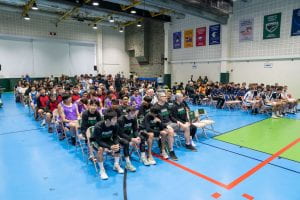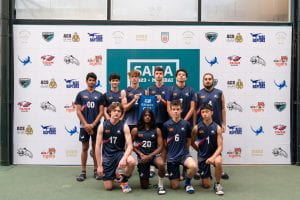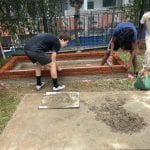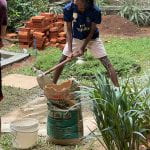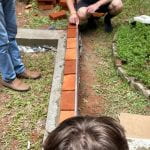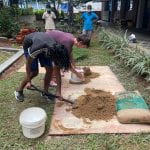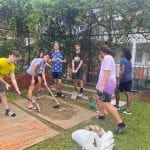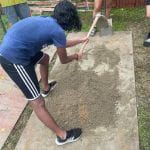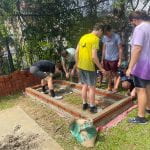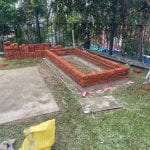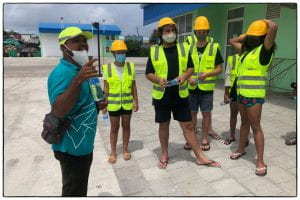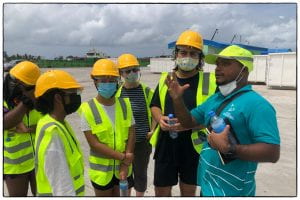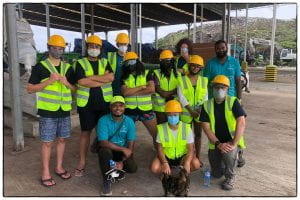
Source: worldatlas.com/maps/maldives

Source: gisgeography.com/maldives-map/
Over the course of the Vesak holiday weekend, the Environmental Systems and Societies class went to the Maldives in order to learn about biodiversity, conservation and waste management.
The trip as a whole was a learning experience in a lot of ways. Firstly, learning about the Maldives as a whole, how the country operates and functions. We learned about how religion can largely govern the country, transportation and urbanization. These things were not explicitly mentioned to us but were things we observed along the way. We also went to dedicated locations to learn about more niche things, such as the trash island Thilafushi to learn about trash management, or Villingilli to meet with Beybe and learn about coral restoration and the NGO Save the beach.
Travel Day
The trip began at 1:15, on Friday 13 (a great day for a plane ride). It was pretty much a standard flight except we got there a bit early so we had to wait for the terminal to open. We arrived in Hulhule at 8:15 local time after a turbulent 1 hourish ride. From there, we just waited in the airport until a boat came to pick us up to bring us to our first location, Kaani Guesthouse, in Maafushi. We had some food, changed and took our first snorkel in the Maldives just off the coast (in the bikini-free area, which was less crowded and therefore a better spot for the coral restoration zones off the beach). There wasn’t that much coral or anything but we got to see how people use metal frames to attach and grow coral. In these areas the fish population was noticeably significantly more dense, because of the shelter that the frames and growing coral offered.
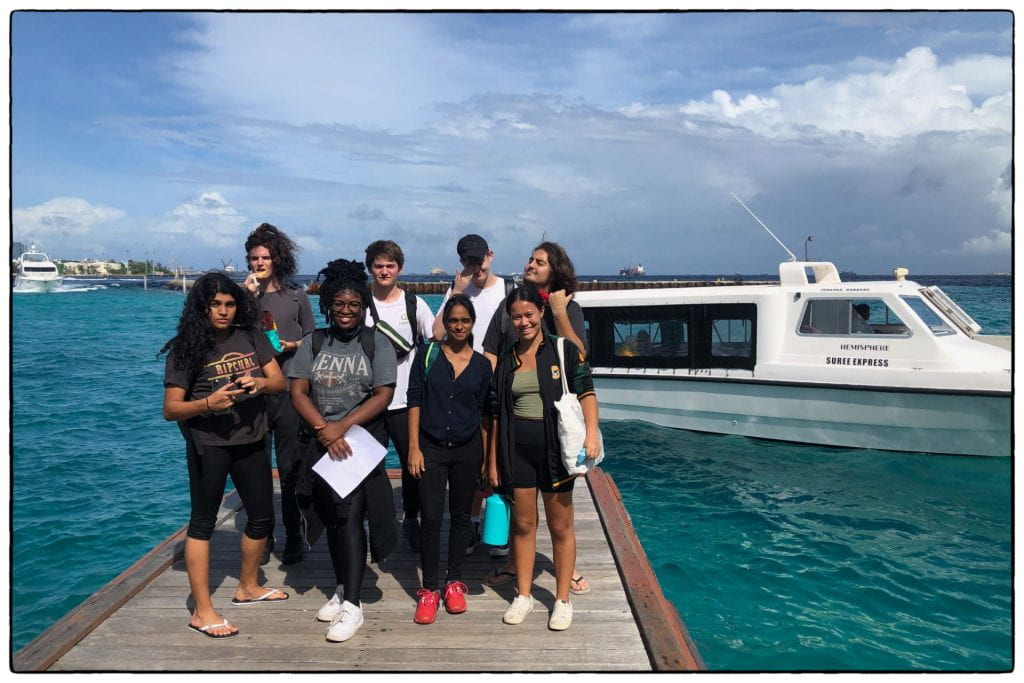
Maafushi
Following that short swim, we had a proper lunch and waited for our rooms. At around 4 we met with the island council chief, Mr. Hasan Solah, to discuss some of the infrastructure on the island, focusing on the waste management, renewable energy and water filtration systems in place on the island. Maafushi was home to a large local population and was more of a local island than a resort island as most islands are. Furthermore, Maafushi houses a prison, and therefore generates a lot of waste. Because of this, the island was home to a smaller scale waste management program, which involved a large landfill with burning patches to get rid of combustible waste, which in 2018 processed 1,733 kg of waste a day. The island did have an incinerator but it was out of commission when we went so we didn’t get to see it in action.
We also visited the water filtration plant where Mr. Solah gave us a tour of the facilities and explained how they stored the water. I won’t discuss the water filtration Maafushi as much as our next destination at Embudu village had a much more in depth tour.
The final part of our tour that day was at the island generators. We were told that the island had a max capacity of 6.5 megawatts, but usually operated at a max load of 2.7 megawatts. After the tour we played volleyball with local kids on a wet carpeted court. We played for about 30-40 minutes and went back to the hotel to get cleaned up after.
Our first dinner in the Maldives was great, I had firsts, seconds, thirds, and probably 4ths. Safe to say we ate well.
Maafushi
Anyways the next morning there was terrible weather so our whole day’s agenda was pretty much thrown out the window. After waiting in our hotel for the ocean to calm down, we got to go on a guided snorkeling tour of the coral restoration site and the surrounding area. On this tour we saw a bunch of cool fish, the usual things like parrotfish, moorish idols, trumpetfish, surgeonfish, butterfly fish, triggerfish, sea cucumbers etc. In addition we saw a lionfish lurking in a coral cave, which was my first experience with the invasive species. Lionfish pose a problem to ocean ecosystems because in most places they don’t have a natural predator (and have venomous spines that deter attackers), and are highly aggressive, with stomachs capable of expanding up to 30x their normal volume, putting massive strain on ecosystems.
-
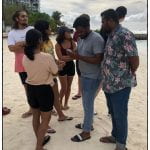
-
Maafushi tour with Mr Hasan Solah
-

-
Nik Snorkeling
Credit to Mr Lockwood for all pics in this gallery
-

-
Jade snorkeling
-
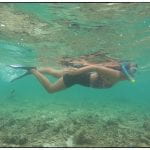
-
Yangki snorkeling
-
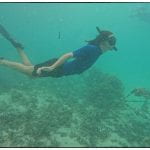
-
Josh snorkeling
-
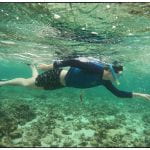
-
James snorkeling
-

-
A bunch of us snorkeling
We managed to leave the island at around 2, after lunch. The boat ride was less than 20 minutes. Our destination was Embudu village, a resort island. Upon arrival the weather was still pretty bad so we could go snorkeling, not yet anyways, so we just played volleyball in the rain.
Embudu
The weather calmed down an hour later, so we settled into our rooms and went snorkeling. Unfortunately the ocean was milky from the waves bringing up sediment from the floor so we didn’t see any cool fish. After the brief snorkeling we jumped off a boat for a bit and ate dinner.
The next morning we went for a snorkeling excursion after breakfast. This was one of the highlights of the trip for me because right off the bat we saw a massive moray eel (~2m), something that I’ve always wanted to see before. The snorkeling trip was a bit interrupted by some strong currents but that didn’t disturb the biodiversity around us. This was the first trip we had the opportunity to see blacktip sharks and starfish. I also followed a pair of large eagle rays for about 25 meters which was another fish I’d always wanted to see. The main attraction of the island however was the coral gardens that were located in a calm section off the shore. The garden was beautiful and had more variations of coral then Id ever seen before (see https://marinesavers.com/corals/). The coral gardens also housed a bunch of clownfish of many colors.
-

-
Boatjumping In Embudu
Credit: Mr Lockwood
-
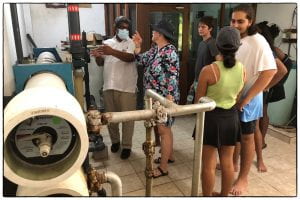
-
Water filtration system in Embudu
Credit: Mr Lockwood
-

-
Maldivian Coral Species
Source: marinesavers.com/corals/
-

-
Josh on a dock
-

-
Solar water heating at Embudu (something that most resorts have)
-
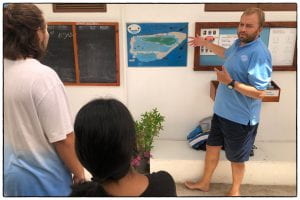
-
Dive instructor explaining topography of island
-

-
Snorkeling at Embudu: at this point the eel was ~30m away
After the snorkel, we had a tour of the island, focused on how electricity is generated on the island which was with some generators and a solar panel grid located on top of buildings on the island (480 kilowatts total) and water filtration and waste management. Embudu incinerated all combustible waste and glass, piping the CO2 and other products of combustion into the air so it didn’t affect the island too much. They did not regularly use the plant if I remember right, mostly to minimize excess trash as they used the local waste management options; trash boats to Thilafushi and maybe Maafushi if I remember correctly.
The biggest part of the tour was the water filtration system on the island. The island used a reverse osmosis system; basically a system that uses a semi-permeable filter to separate unwanted molecules and larger particles from drinking water. The system did not dilute all water as I previously thought, it left some water in greater concentration. The liquid, more concentrated leftovers were dumped into the ocean offshore (the concentrated liquid had no ecological impact as I was told, so it did not harm the environment).
In addition to seeing the basic infrastructure of the island we got to see the clothing washing room, home to enough washing machines and dryers to make a laundromat jealous, and the bottling plant. At the bottling plant we were explained by the manager of the island that one of the islands main focuses was completely removing plastic bottles. This was an easily understood goal as on the island plastic bottles were all we could get for any drink, be it water, coke or apple juice. Obviously working in an industry so heavily dependent on the environment would mean that plastic bottles are a massive no-no. In fact, the entire Maldives aims to have completely outlawed single-use plastic by 2023.
Male
A quick lunch later and we were on the way to Mahagiri Hotel in Male by speedboat. After getting checked in at 2:30, we were free to walk around the town or spend time working on schoolwork. I managed to finish my TOK exhibition during this time so it was academically good but hearing stories from my classmates that went walking made me a bit jealous.
-
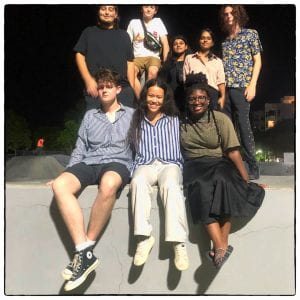
-
Dinner by a skatepark
Credit: Mr Lockwood
-
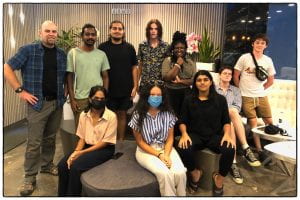
-
Lobby of Mahagiri Hotel in Male
Credit: Mr Lockwood
Our final day in the Maldives started with a car ride to the ferry station, so that we could get to Villingili and meet with Beybe from the NGO Save the Beach. Save the Beach is a prominent activist group in the Maldives focusing on coral restoration, cleaning up beaches, promoting eco-friendly lifestyles for locals and minimizing other ecological damage caused by infrastructure projects in the area (namely the big port built on Villingili).
Villingilli
Beybe talked about the conservation efforts on Villingilli specifically because of the port built there 20 years ago. According to Beybe, coral in the area went down to 7% of what it used to be directly following the construction. Because of the various coral restoration projects on the island that figure was up to about 23%. He explained to us how they restored coral by relocating it from unsuitable habitats and connecting them to a series of frames so that they can grow outwards and create excellent habitats for the ocean life in the area. Another thing they did was set up a screen between the port and main coral restoration project so that silt and other debris kicked up by the construction was prevented from interfering with coral growth. The other initiative discussed was the reduction program that helped Villingilli locals become more aware of the consequences of pollution, specifically plastic or waste pollution, and what they can do to help the reef. This program was extremely successful as Beybe proved by telling us about the massive reduction in daily trash, going from a number in the high 20s to around 7 if I recall. This drastic change shows that the population of Villingilli had changed over time, and they wished to spread that change to those who visited the island.
Villingilli was more similar to Maafushi than Embudu in the sense that it was a local island, one without too many resorts. Villingilli had a mosque, school, convenience stores and everything as we saw on our tour of the island however the island’s biggest asset was its magnificent coral which was impressive by Maldivian standards and therefore world class in every way.
We went snorkeling nearby the coral restoration project allowing us to see the way that the coral spread and grew over time. He pointed out newer bunches and ones that had grown in the years of the project. The coral in this area was splendid, the visibility around 20 meters and the biodiversity second to none. Within minutes of snorkeling Eleez, Josh and I spotted a spotted moray eel that I reckoned to be a laced moray. Another interesting fish I saw was a neon yellow trumpetfish, several boxfish of moderate size, sea urchins (of the humongous size), toadfish and pretty much everything we saw before on other islands just with greater amounts. This was the best snorkeling we experienced on the trip.
Thilafushi
From Villingilli we traveled to the trash island, Thilafushi, which served as a hub for waste management in the atoll as I understand it. Some project managers greeted us with cool hard hats and vests and explained the function of the island and the way that its methods are going to have massive change. Trash was now being sorted better, by a series of construction machines and a conveyor belt (which had an electromagnet to gather metallic waste and separate it from compostable waste.). In addition to this, we saw a really cool machine at work, which compressed and then wrapped the compostable waste into plastic covered, compact waste bales essentially. These were far more space efficient and by reducing open air in the trash pile the ongoing issue of a non-extinguishable fire on the island could be solved as the root of the problem was methane buildup underneath years of garbage, editing and staying alight under the pile surface. Compact, wrapped trash bales solved this problem. The island processed an undetermined amount of trash daily, information which I will add later. Future initiatives on the island will enable the island to process more garbage then is dropped off, effectively reducing the pile day by day. They also plan on getting more efficient incinerators which will use energy generated from combustion to power the incinerators, essentially making the incinerators self-sufficient and significantly more sustainable and efficient.
Assortment of Thilafushi waste island pictures. You can see us repping the awesome vests and helmets which had built-in eye protectors
Credit: Mr Lockwood
Bandos
From Thilafushi we went back to Male to collect our baggage for a 4 hour trip to a neighboring island Bandos for a late lunch and some time to recompose ourselves before the flight back home. For me and Nik, Bandos meant an opportunity to play volleyball with the workers there, many of whom knew Nik since his infancy. They knew me from a prior trip to the island. We played for an hour and a half (the sea was too rough to snorkel) while everyone else explored the island and swam. From there, all we did was clean up and get ready for the flight back. The flight itself felt much shorter, probably because there wasn’t turbulence, and just like that we were back home.
The trip as a whole was a great learning experience for me. As a whole, I have a much greater understanding of coral restoration and waste management specifically, because of the extent that we learned about it. Underwater biodiversity was another key part of the trip obviously, and most of that learning was done by ourselves, since we didn’t get guides most of the time. The trip exemplified CAS learning outcomes like global engagement and considering ethical impacts because of the concepts and ideas that we learned as well as collaboration because we did everything together, forcing us to work in unison. Overall a great trip from both an academic and tourist perspective.

